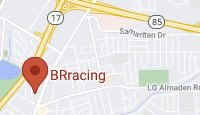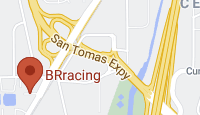We’ve embarked on another venture, another journey, to the dark side again.
To develop and refine the Porsche Cayman S into a healthy track warrior, but that will still be driven on the street on a daily basis. The car is truly a daily driver….driven a lot, used daily for the normal work commute, this is not a garage queen that also sees the track. This means this is a project that will live by the mantra again of “street car that can be taken to the track”, versus a track car that can be driven on the street. That statement, objective, requirement, will play heavily as we make the decisions on what to do to the car all through the development program. The Porsche Cayman is caught between a rock and a hard place by Porsche themselves. The car has all the benefits and enhancements from a design standpoint that you would want to add or alter to the iconic Porsche 911….which is Porsches’ bread and butter, and as a result, Porsche doesn’t want to do a lot of enhancements to this car, and the more power and handling that get added, the closer (and maybe even it would be better….we will see) it becomes to eclipsing the position the famed 911 holds.
Here is the base canvas for this project, a Porsche Cayman S (987.1) – 2006

Initially, our focus will be on safety and handling. Here we go –
HANDLING – Step 1
The Cayman S is a very stable platform to begin with, so there are not a lot of items that we have to chase or address to alter the behavior, we just want to step up the performance and capabilities of the car. So, part of the standard process and issue with the current breed of Porsches (987/996/997) is the soft suspension bushings. The deflection they allow robs the driver of confidence under braking and during all elements or phases of cornering. I remember my first time doing threshold braking at the end of a long straight, and I thought something was seriously wrong with the car. The rear end was wanting to wiggle back and forth, and I wasn’t sure the car would obey and stay straight….as a result, your confidence when driving hard was robbed…you just weren’t sure. So, we need to solve that issue, we need to solve the soft bushings that allow toe deflection under load, so that the car will track true and straight, and go where we want the car to go. On the Cayman, the main culprit is the thrust arm bushings, which are both front and rear (all four lower control arms). For this car, we choose the GMG thrust arm bushing set.

Next, we want the car to also be stable and flat under cornering….we wanted to get the most grip we could from the tires. To address that, we would be replacing the stock sway bars and sway bar end links. In sway bars, one of the items that we find amusing, is that the theory seems to be that “bigger must be better”. We’re not sure where this theory took root, or gain its following, but its not necessarily the truth. On our race cars, if we have done the overall design right, then we would prefer to have very little or very small diameter sway bars. But, that’s on a race car where we have had the option to optimize the whole suspension geometry, lower the center of gravity and weight of the car. On a street car that will see track duty, we don’t have those same options, and we have to live with what we have. Therefore, sway bars can be an effective tool to help in the overall handling of the car. But, usually a gain of one sort with sway bars means you are losing some place else. If we increase the stiffness of the rear sway bars to help the car on initial turn in, what we really have done is just take away mechanical grip from the rear….this allows the front to now have a greater percentage of the total effective grip, and as a result, the car gains grip at the front, and understeer is reduced. We didn’t really improve the overall mechanical grip of the car, we lost some, but we shifted grip to where we needed it at the right time. On this project, we have both issues. We do want to increase the anti-roll characteristics of the car….that also helps keep the tire contact patch maximized….which means we gain grip, plus it just makes the car easier to drive. So, to this car, we are adding Tarett front and rear adjustable sway bars, and Tarett adjustable sway bar end links. The Tarett bar set comes with the upgraded sway bar bushings (doesn’t do any good to increase or upgrade the sway bar if the sway bar either uses the stock bushings or didn’t upgrade the bushings….you’re just transfering or absorbing energy in the bushing instead of transfering the energy to the car. The sway bars also feature bushing washer stops on the bar, which prevents the sway bar bushings from walking out of the bushing carriers or caps, which we have seen happen on many cars that don’t use or have this feature. The adjustable sway bar end links do the same, but also provide for the length adjustment so that the “pre-load’ on the sway (if desired) can be dialed in, or we just gain solid joints on all connection points.

To further improve grip at the front, we swapped out the front lower control arms for Tarett GT3 adjustable front lower control arms (can also be used at the rear). The advantage of these arms is that they allow for camber adjustment on the lower arm by being able to add or change the width of the inner control arm shims…we can go from 1mm up to 10mm…..that’s a lot of camber change that we can effect. The stock Cayman has front camber of 0 degrees to -0.5, which is no where close to what we want. With these lower control arms, and not lowering the car any (yet), we can increase the negative camber to -2.3 degrees… a huge change, and just where we want the front to be.
BRAKES – Step 1
If we’re going to increase the speed and handling of the car, then another related element of getting more speed out of the car on the track is we need to ensure we can stop. But, this doesn’t just mean increasing the braking capacity, but we want to ensure we will have brakes that can take the huge increase in heat and abuse from track use. The jump in the amount of heat generated under track conditions is very large…and just changing brake pads, lines, and fluid will NOT get you the answer you need. We hear from so many customers, ” I changed my pads, lines and fluid, yet I’m still running out of brakes”…..hmmm, the issue is the total heat package and impact. You need to address the ability to absorb, dissipate, and tolerate massive amounts of heat. So, we recommend for ALL track customers that the make the big jump, and spend the money on a big brake kit upgrade. This both solves the heat issue, and increases the total braking capacity…..a WIN-WIN solution. The other often misunderstood element about Big Brake Kits (BBKs) are that the increase in braking capacity comes from the larger rotor and pads….while they are an element, they are not the prime contributor. The biggest change comes from moving the center of pressure out farther….increasing the “moment” arm of braking pressure. This is accomplished by both moving the caliper out farther, but also in the caliper design, that allows the center of pressure of the caliper to be out farther, closer to the outer edge of the caliper. That’s why the design of the caliper is critical, and often you will hear brake manufacturers talk about the strength of the caliper…as it becomes a concern when you thin the outer element…..look at a stock brake caliper, and the amount of metal or mass on the outer side of the caliper versus a BBK caliper, significant leap or change. You can also see this on stock calipers…the brake pad does not cover the outer edge of the rotor, yet on a BBK, the pad will indeed go all the way to the outer edge of the rotor. Now, if we have moved the center of pressure out, then we also will need to increase the brake rotor size….that’s why they have bigger rotors. The two elements go right together. The other advantage of a good BBK is the ability to deal with heat, and the ability to dissipate heat. There is a LOT of science that goes into the rotor vane design….the air flow characteristics, so much so that many brake manufacturers have patents in this area, due to the advantage they have gained (like StopTech and Brembo).
So, a lot of verbage to say that we are upgrading the brakes on this Cayman S. We need BIG brakes. We choose to go with StopTech ST60 (6 piston front caliper, 2 piece rotors w lightweight inner hats) for the front, and ST40 (4 piston rear caliper, 2 piece rotors w lightweight inner hats) for the rear. There are lots of pad choices, and we’ll talk about that later.
Here are some pics of the new pieces, as well as a comparison of the new versus the stock –





To further aid in the complete brake solution for the car, we also added GT3 front brake cooling fins to the inner fender liners. As you can see from the photo above, there are vents to provide air flow to the inner fender area, but we needed to direct them to the brake area, and the GT3 has specific front and rear cooling fins to assist in this. So, we added those to this Cayman S as well.
SAFETY – PS Cooler
Now, normally, when you see a heading like safety on a track car project, you think of seats, harnesses, and roll bars. Which we will add below as well. But, one of the areas that is a weak link on the Cayman is the power steering system. It tends to overheat, and the lines tend to go “splat” and split open, or leak, and pour fluid on the track just in front of your wheels so you can experience what its like to go ice racing…..just ask us…we know from personal experience what this feels like, or worse, what happens when you lose all traction at high speed. So, not going to let that happen here, so we are going to address the heat issue (add a better ps cooler), the line issue (replace ps lines and fittings w race versions, stainless steel lines and AN fittings, and race PS high pressure hose (the blue stuff ) on the high pressure outlet hose. You can read the full details here –
BRR Cayman S Power Steering Cooler
Here are some quick pics and additional views of the solution on the front (on a 987.1 Cayman S, you can put the cooler in the front main duct opening, on a 987.2 Cayman S w PDK, that area is taken by another radiator, so we would move the ps cooler to one of the side radiator areas, like the left front, just behind the current main radiator there).




And we know, that this was not just a good idea, but one that works very effectively. This car with this upgrade has now seen over 20 track days and events without any incident or issue, and the ps system has worked very effectively.
More to come…..SAFETY on the inside of the car as well


